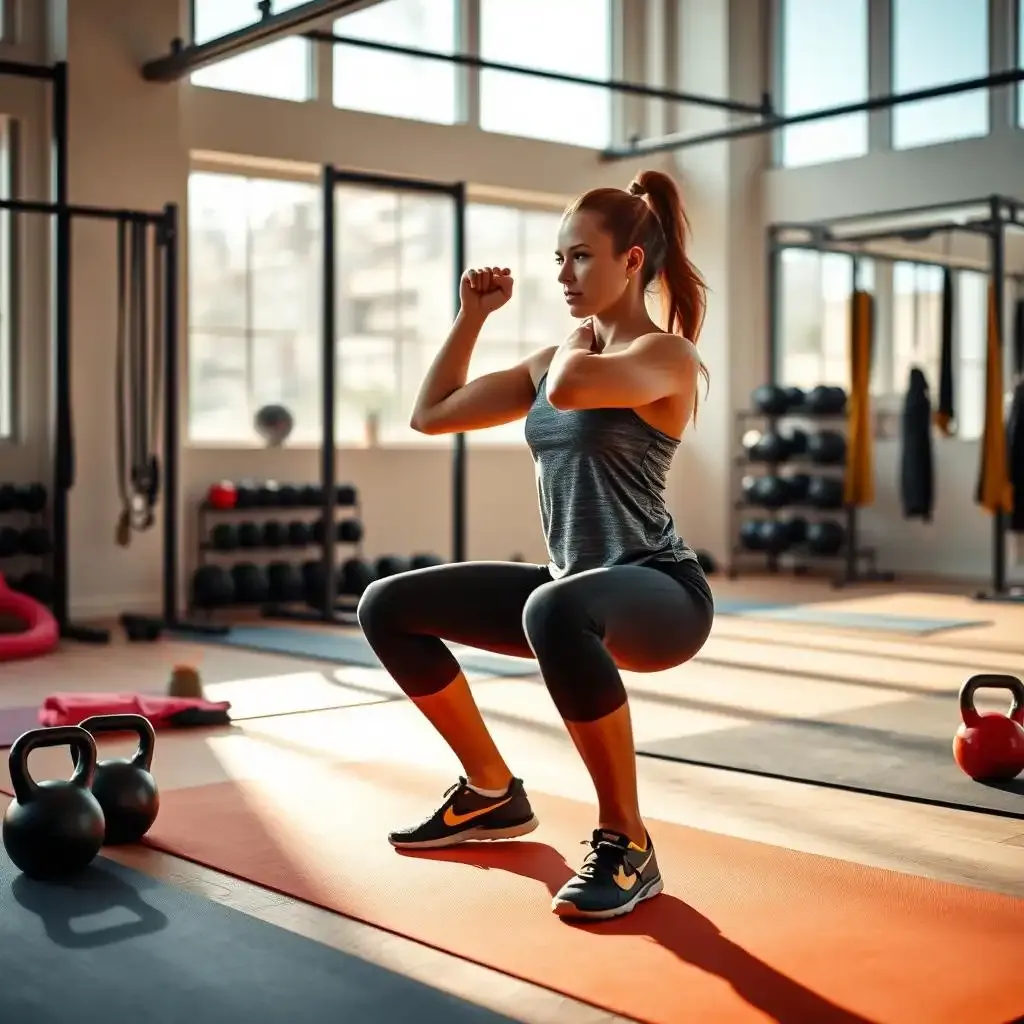Table of Contents
Ready to ditch the gym and sculpt your body using just your own weight? Welcome to the world of calisthenics! This beginner calisthenics workout guide from kizworld will help you build strength, improve your fitness, and feel amazing, all from the comfort of your home. Forget expensive equipment and complicated routines; we'll start you with simple, effective exercises you can master quickly. We'll cover the basics, show you some killer moves, and teach you how to make this workout a sustainable part of your life. By the end, you'll have a solid foundation for a stronger, healthier you. Let's get started on your beginner calisthenics workout trip!
Key Takeaway | Details |
|---|---|
What is a beginner calisthenics workout? | A workout using your bodyweight as resistance, requiring no equipment. |
Benefits | Improved strength, flexibility, cardiovascular health, and weight management. |
Example Exercises | Squats, push-ups, planks, lunges, crunches, jumping jacks. |
Workout Frequency | Aim for 3-4 sessions per week, allowing rest days for recovery. |
Progression | Gradually increase reps, sets, or try more challenging variations. |
Safety | Proper form is crucial to avoid injuries. Start slowly and listen to your body. |
Resources | Numerous online resources and apps offer guided beginner calisthenics workouts. |
Beginner Calisthenics Workout: Your First Steps to Fitness
Hey there, fellow fitness enthusiast! So you're diving into the amazing world of calisthenics? Fantastic choice! I've been hooked for years, and it's seriously changed my life. Forget those clunky gym machines; with calisthenics, your body is the equipment. It's all about using your own weight to build strength, stamina, and flexibility. Think of it like this: you're sculpting your physique, one push-up, one squat, one pull-up at a time. It’s like building with LEGOs, but instead of bricks, you’re using your muscles! And the best part? You can do it anywhere – your backyard, your living room, even a park! No fancy equipment needed, just you and your awesome body.
We'll start super simple. Think basic moves like squats, push-ups (on your knees if needed!), and planks. These form the bedrock of any good beginner calisthenics routine. Don't worry about fancy moves yet; focus on mastering the basics with perfect form. Remember, proper form is key to preventing injuries and seeing real results. Think of it as learning the alphabet before you try to write a novel. Mastering the basics will let you progress to more advanced moves, like dips and pull-ups, later on. And hey, if you need some extra inspiration for a killer routine, check out our beginner calisthenics routine page for some extra ideas.
Exercise | Sets | Reps | Rest |
|---|---|---|---|
Squats | 3 | 10-12 | 60 seconds |
Push-ups (on knees if needed) | 3 | As many as possible | 60 seconds |
Plank | 3 | 30 seconds | 60 seconds |
One thing I love about calisthenics is how adaptable it is. You can easily modify exercises to match your fitness level. Can't do a full push-up? Start on your knees! Feeling ambitious? Try adding some variations, like incline push-ups or decline push-ups. The possibilities are endless! It's all about finding what works for *you*. It's your progression, your pace. Don't compare yourself to others; focus on your own progress. And remember, consistency is key! Aim for at least three workouts a week to see real results, building up to four as you get stronger. If you’re looking for something a bit more structured, check out our fitness programs page for some extra options.
- Listen to your body. Rest when you need to.
- Don't push yourself too hard, especially when starting out.
- Focus on proper form over speed or quantity.
Remember that amazing feeling after a good workout? That's the reward for your hard work. Calisthenics isn't just about getting stronger; it's about building discipline, resilience, and self-confidence. It's about feeling empowered by your own strength. And hey, if you're looking to take your calisthenics game to the next level, maybe check out our guide on calisthenics exercise routines for some ideas on how to progress. It's all about gradual progress, not sudden leaps and bounds. Think of it like climbing a mountain: one step at a time.
“The body achieves what the mind believes.” – Napoleon Hill. This quote perfectly captures the essence of calisthenics. Believe in your ability to progress, and you will. It’s a mental game as much as a physical one. If you're interested in learning more about the incredible benefits of calisthenics, our beginner calisthenics page has more info. You got this!
Beginner Calisthenics Workout Routine: Exercises and Progression
Beginner Calisthenics Workout Routine Exercises And Progression
Okay, so you've mastered the basics – squats, push-ups (maybe still on your knees, and that’s totally fine!), and planks. Awesome! Now it’s time to level up. Think of it like building a LEGO castle: you started with the base, now we're adding towers and battlements. We're going to add some new moves to your routine, and the key here is *gradual* progression. Don't try to run before you can walk – or, in this case, do a handstand before you can do a proper push-up.
Let's introduce some variations. Remember those push-ups? Try incline push-ups (hands on a bench or wall), making them easier. Then, work your way up to decline push-ups (feet elevated), which are harder. It’s all about finding the sweet spot where you’re challenged but not overwhelmed. The same principle applies to squats. You can add a jump at the top for extra intensity, but if you’re struggling with regular squats, don’t even think about jumping squats just yet! For extra ideas on adding variety to your routine, check out our page.
Exercise | Beginner Variation | Intermediate Variation |
|---|---|---|
Push-ups | Incline push-ups | Decline push-ups |
Squats | Bodyweight squats | Jump squats |
Plank | Standard plank | Side plank |
Another fantastic exercise to add is lunges. They're great for your legs and glutes. Start with stationary lunges, keeping your front knee behind your toes, and then progress to walking lunges. Want to make them more challenging? Try adding a jump between each lunge. Remember, it’s all about building strength and stamina gradually. Don't rush things. Your body needs time to adapt. And remember those rest days? They’re not optional; they are essential for building muscle. Treat them as sacred!
Now, let's talk about how to actually *progress*. There are a few ways to do this. You can increase the number of repetitions (reps) you do of each exercise. For example, if you're doing 10 squats now, aim for 12 next time. You can also increase the number of sets. Instead of doing 3 sets of 10 squats, try 4 sets. And finally, you can increase the difficulty of the exercise itself, as we discussed with the push-up and squat variations. To find more exercises to add to your routine, check out our page. It's packed with ideas!
- Increase reps (repetitions): Do more of each exercise.
- Increase sets: Do more groups of reps.
- Increase difficulty: Try harder variations of the exercises.
It’s important to listen to your body. If something hurts, stop! Don’t push through pain. A small ache is one thing, but sharp pain is a clear sign to take a break. Remember, consistency is key, but so is rest and recovery. If you're looking for more structured workout plans, check out our page. We've got something for everyone!
One last thing before we move on: Don't compare yourself to others. Everyone starts somewhere. Focus on your own progress and celebrate your achievements, no matter how small. You're doing great! And if you're looking for even more inspiration, check out our page on street workouts for some extra ideas. It’s all about finding what works for you. You are unique!
Beginner Calisthenics Workout: Safety and Consistency
Beginner Calisthenics Workout Safety And Consistency
Starting Safely: Listen to Your Body
Hey there, future calisthenics champion! Before you even think about attempting a handstand (unless you're already a pro, then go for it!), let's talk safety. Calisthenics is awesome, but like any workout, it's important to start slow and listen to your body. Think of it like building a house: you wouldn't start by putting the roof on before the foundation, right? Same deal with your body. Begin with simple exercises like squats and push-ups (on your knees if you need to!), mastering perfect form before you move on to more challenging moves. Remember, proper form is key to avoiding injuries. If something feels wrong, stop! Don't push through pain; that’s a recipe for disaster. We want you to enjoy this process, not end up on the sidelines with an injury. Check out our for more tips.
- Warm up before each workout.
- Cool down after each workout.
- Listen to your body and rest when needed.
Consistency is King (or Queen!): Building a Habit
Consistency is what truly transforms your body. Think of it like watering a plant – you wouldn't expect it to grow if you only watered it once a month, would you? Aim for at least three workouts per week. Find a time that works for you and stick to it. Make it a habit, like brushing your teeth. It might seem tedious at first, but trust me, the results are worth it! And don’t forget rest days! Your muscles need time to recover and grow stronger. Overtraining is a real thing, so listen to your body and take breaks when you need them. Need some ideas for structuring your routine? We've got some great that can help!
Day | Workout | Rest |
|---|---|---|
Monday | Beginner Calisthenics Routine | Rest |
Tuesday | Rest | Rest |
Wednesday | Beginner Calisthenics Routine | Rest |
Thursday | Rest | Rest |
Friday | Beginner Calisthenics Routine | Weekend |
Saturday | Weekend | Weekend |
Sunday | Weekend | Rest |
Making it a Lifestyle: More Than Just a Workout
The coolest thing about calisthenics? It's not just a workout; it's a lifestyle. It's about building strength, yes, but it's also about building discipline, resilience, and self-confidence. It's about feeling empowered by your own body. Think of it as a progression, not a race. There will be days when you feel amazing, and days when you feel like crawling back into bed. That's okay! The important thing is to keep showing up, keep pushing yourself, and keep celebrating your progress, no matter how small. Remember, even small steps forward add up to massive achievements over time. For even more inspiration, check out our page on – they're super fun!
“The difference between ordinary and extraordinary is that little extra.” – Jimmy Johnson. This perfectly sums up the magic of consistency in calisthenics. It's those little extra reps, those extra sets, those extra workout days that will lead you to become stronger and more confident than you ever thought possible. We believe in you – now go get it!
Final Thought
Starting a beginner calisthenics workout is a fantastic step towards a healthier, stronger you. Remember, consistency is key. Start slow, listen to your body, and gradually increase the difficulty as you get stronger. With dedication and the right approach, you'll be amazed at what you can achieve using only your own bodyweight. Keep exploring new exercises and variations, and enjoy the process to a fitter, more confident you!